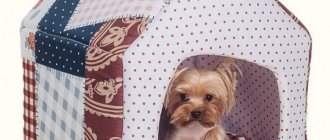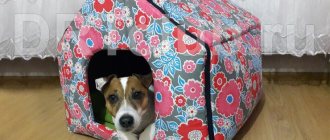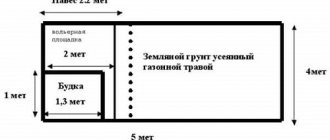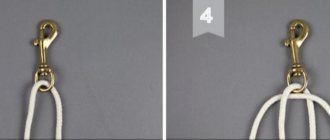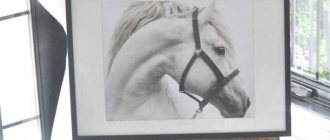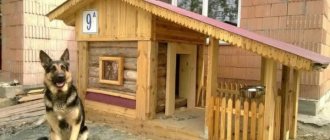It doesn’t take much time to make a cat house with your own hands, and expensive materials will only be needed if the master plans to design something unique.
To make a frame, it is enough to prepare cardboard, glue and a sharp knife, and the pasting can be made from the remains of old clothes. All owners can implement such a project for a budget house for a cat with their own hands - pets will be very happy to acquire a comfortable and practical “real estate”.
Peculiarities
The cat house performs several functions:
- shelter - a place where you can hide from the other residents of the house;
- observation point - the pet should be able to view the maximum space around from it;
- a warm, cozy nest where you can sleep or just lie down and soak up;
- play area with scratching post , ribbons, tunnels and other play accessories.
An original house for a cat
Thus, in order to look attractive to cats, the house must be:
- according to the size of the cat - it should fit freely into it and be able to freely curl up into a ball, but it is important not to overdo it with the dimensions;
- consist as much as possible of natural materials - wood, cardboard, natural felt and others (synthetic materials electrify the fur of cats, and this causes discomfort - plastic, artificial fabrics);
- away from equipment and objects that produce loud sounds - away from TV, radio, music center;
- moderately warm, not exposed to drafts - cannot be installed under windows, on a windowsill, close to a radiator, near a door or passage.
IMPORTANT! The ideal option is to arrange a resting place for the cat in the far corner, relative to the entrance to the room or against the wall located opposite from the entrance.
Stylish cat house
The house should be the size of the pet
It is very important not to forget about humidifying the air in rooms where pets are kept. Read our separate article on how to make a humidifier with your own hands. And also, which humidifier is better to choose.
What is he like?
A house for a cat must meet all the requirements of a four-legged friend walking on his own. First you need to study the habits of the cat. Perhaps he is quite playful, then he needs to organize special homemade devices for games.
Some cats prefer to sleep, then you should take more care of the resting place. Some cats prefer to sharpen their claws on their owners' furniture , which not only irritates, but also infuriates a person at the sight of damage to expensive property. Homemade scratching posts and cat houses can solve the problem.
Wall complex with scratching posts
So, you have analyzed your cat’s preferences and are now deciding on a design model. This may include:
- Additional “devices” for exercise. Playful cats need a place to burn off their energy. Along with the covered house, install additional poles with tabletops wrapped in twine. Such houses can also be found on sale in specialized stores, but their cost may exceed the permissible family budget. They are easy to make yourself from plywood and other building materials.
- A back door in a cat house is required. The cat can pounce on the enemy, hide in its shelter and change its hiding place using the back door. When in danger, a cat will take out the kittens through an additional move, and then rush at the enemy. This is the nature of cats, you can’t argue with them.
- The dimensions of the cat house should be calculated in advance. If the four-legged pet is of medium size, then it will be enough to make a house with an entrance with a diameter of 15-20 cm, and the dimensions of the “sleeping” place and shelter in the form of a cube with an edge of 40 cm. Next, proceed from the given indicators. The dimensions of additional devices in the form of beds and other utensils should also be selected in accordance with the size of the animal. Standing on its hind legs, the pet should reach with its front legs.
- The use of a scratching post as an additional attribute should also be thoughtful. Firstly, it must be made of durable material that can withstand all the pressure. Secondly, it must be accessible from any corner of the erected structure.
- Study your pet's habits according to the characteristics of its breed. For example, Siamese or Bengal cats love to stand on their hind legs. For them, you should make a wigwam house with a height of at least 60 cm.
It should also be noted that the design of the house may vary significantly depending on the gender of your pet.
For example, cats are more playful and love to hunt, so they should build a building with a large view. Here you can stay at the sleeve house .
Sleeve house for cats
For a cat, it is better to make a two-level design , where the upper level will help look out for the enemy, and the lower level will use the mother of the newly hatched offspring for an ambush, and if danger approaches, she will attack the future offender.
Two-level houses are preferable for cats
Also, you should not allow a large view of the cat's house - she prefers to ensure the safety of her den.
Watch in this video how to make a play complex for a cat with your own hands at home.
Pets bring us a lot of joy and warmth, but wool is an integral part of their presence in the house, so it is important to take care of cleaning the air in the apartment. Read our separate article on which air purifier to choose for your apartment.
Photo
The following photos show various options for making houses for cats.
Using wool felting technique
Wooden summer house
From cardboard
Wigwam
Knitted bed
Hammock for cat
Game complex - step-by-step instructions
a cat house with your own hands from scrap materials. Here you will need a little skill and a little skill. If you are not a master at working with a hammer and nails, you can use simple methods to erect a structure.
Cardboard house
The play complex for cats is especially popular among ordinary people and cat breeders, as well as pet store sellers, because this is where you can find all the variety of housing for animals. Take this opportunity and carefully consider such designs, so that you can then create your own version of the “living space”.
Play complex made of sawn wood
As a rule, the presented type of complexes has a high cost, however, the cost itself does not exceed several hundred rubles. Sometimes the necessary materials are available.
Necessary materials
So, to build this kind of structure you will need the following materials:
- plywood no more than 10 mm thick;
- polyethylene pipe with a diameter of up to 12 cm;
- furniture metal corners in the amount of 15-25 pieces;
- any natural rope, you can take hemp or jute;
- liquid glue without a strong odor;
- any material your pet likes (you can find out by his favorite place to sleep) for lining the house;
- tools for work.
Master class on making a cat house with your own hands:
- Cut 6 squares from plywood in accordance with the size of the future recreation area. In two of them make round holes - the main entrance and the back door.
- Connect the walls of the home together into a kind of cube using furniture corners. Before attaching the part with the main entrance hole, upholster the inside of the house with material. A layer of foam rubber should also be placed under the material. Attach "entrance".
- Use a pipe to create an observation deck. You can first coat it with glue, and then tightly wrap the rope around it.
- Cut a square or rectangle according to your pet's size to create a viewing platform . Cover it also with material, having previously placed foam rubber.
- Attach an observation deck using corners to the pipe.
- The pipe is attached to the roof of the manufactured house, which can also be pre-upholstered with material on the outside, but without foam rubber.
This house model is the simplest and is used as a basic option. Of course, the owner can improve the housing for his pet in accordance with his preferences . Sometimes an additional play pendant is attached at the bottom of the viewing platform.
This combination option is possible, but only if the entire structure is fixed to the floor, because an unstable house can be turned over during play, which will lead to injuries to the four-legged pet. Think through everything carefully and with the possibility of possible unpleasant incidents.
Multi-storey plywood structure for a cat
Complex projects are best made from wood. This material allows you to implement any sketch and, what is very important, you can later return to refinement and improve the complex by adding additional elements to it. At the same time, drawings with the dimensions of a cat house, for example, made of plywood, should immediately provide for the future development of the play area. Otherwise, you will have to redo the base and make changes to the entire structure.
Production of a gaming complex in stages
If the owner plans to make a play set for a cat, it is not recommended to skimp on the size of the stand platform. It should be big and strong.
- The main cat house should be placed in the middle. In the future, such a layout will allow organizing space to the left and right of the main building.
- If the base platform is deep enough, then you can use the space behind and in front for additional accessories - ladders, passages, placement of soft sleeves and other similar labyrinths. In cats, they never go unnoticed.
- Cats traditionally like multi-tiered buildings. Therefore, it is reasonable to plan the placement of elements in advance not only in the horizontal, but also in the vertical plane.
A universal plywood cat house is easy to make with your own hands. In the future, it will be possible to attach any other materials and forms to it - from soft fabric to paper and plastic.
Attaching a tree to the house
Here it is best not to invent anything, but to find a branch of a suitable size in the forest or park.
- Clean off any remaining bark and remove any damage (if any).
- Dry thoroughly.
- Treat with an antiseptic.
- Attach it to the wall of a wooden house with staples, and to the base of the structure with metal corners. The joints of structural elements must be hidden under soft fabric covering. This way the appearance will not deteriorate, and the cat will not be able to get hurt on the iron.
- If the tree has branches, it is recommended to install it with the top down. Then the base is stably connected to the branches at several points.
- A wide wooden viewing platform is installed at the top of the trunk. The cat will be able to climb up and feel comfortable, just like in its natural environment.
Important! There is no need to wrap the tree with rope or cover it with fabric. Natural wood will be an ideal scratching post for a cat.
Making a scratching post with your own hands
Another way to provide a place for your cat to grind its claws is to make a device with your own hands.
- Take a piece of plastic pipe (Ø 150 mm or more). The length is determined by the size of the cat. For a large Maine Coon, you need to provide at least a meter, and for an ordinary outbred one, 60-70 cm will be enough.
- Prepare a thick rope - jute rope is best suited.
- Attach 3-4 metal corners to the bottom of the pipe. In the future, they will be needed for a reliable connection to the base of the playing area.
- If an additional connecting node is planned on the wall of the house, then immediately install a semicircular bracket to the desired height. All metal elements are installed in advance and subsequently covered with rope braiding.
- Wrap the edge of the cord with electrical tape and screw it to the pipe with a self-tapping screw through this seal.
- Another way is to drill a hole at the bottom along the diameter of the rope, pass the tip through it and tie a thick knot on the back side. It will prevent the rope from coming out and will ensure a tight tension of the turns.
- Carefully and tightly wrap the pipe along its entire length, covering the metal parts and leaving no free space between turns.
- At the top, seal the edge again with electrical tape and screw it to the plastic.
A cat house with a hand-made scratching post is already a good foundation for a future play complex. The rope device is somewhat inferior to natural wood, but overall it copes with the task perfectly and withstands the pressure of sharp cat claws for a long time.
From the box
If there is any extra box in the house, you can show your imagination and construct a cardboard house yourself.
To make construction somewhat easier, use a box of suitable sizes so that your pet does not feel cramped in it. You can involve children in the work. They will be interested in feeling like builders.
Cardboard cat house
So, to make a cat house you will need:
- a box with fairly thick cardboard (you can use a Russian Post package);
- carpet or other dense but soft material;
- any water-repellent material;
- sharp knife;
- odorless glue;
- pencils, rulers and other tools for marking;
- wide tape.
Proceed to making a cardboard cat house in the following sequence:
- Mark the main entrance and back door using a pencil and compass. Cut out the holes. Let the main entrance be larger than the back door. But remember that your pet should slide through it easily.
- Tape all edges of the box that open and facilitate disassembly. For greater persuasiveness and protection, you can tape the entire box with tape.
- Further cut pieces of water-repellent material in accordance with the dimensions of the walls of the future house. Carefully bring them in through the “entrance”, lay them out, gradually gluing them to the walls with glue. It is better to use glue for a hot procedure, especially if you have already covered all the walls with tape.
- Separately glue the joints of the assembled box with water-repellent material to keep your pet warmer.
- Now you can begin the exterior finishing. Cut pieces of carpet according to size. The front wall with the entrance is cut out in one piece, glued and only then, after thorough drying, a hole for the entrance is cut out. The hole is cut with a margin of approximately 1-1.5 cm for bending inward. Cut the edge of the carpet diagonally and glue it, “tucking” it inside the house.
- Let the house dry for at least 3 days. After the time has passed, place a pillow in the house and call the cat to rest.
Such self-production options can be slightly improved and modified. Some people prefer to glue the cardboard to fit their designed structure. There is often a multi-room or multi-level structure, which can be easily achieved with cardboard and tape.
Labyrinth of boxes
From newspaper tubes
Masters of weaving from newspaper tubes create amazing works, not forgetting about their pet. So, with the help of an unnecessary stack of various waste paper, you can create a wonderful structure where your pet will be warm and cozy. The following materials will be required here:
- PVA glue;
- scissors;
- knitting needle;
- a stack of newspapers;
- paints or varnish (optional).
A cat house from newspaper tubes is created as follows:
- Cut the newspaper for blanks into long strips approximately 7-12 cm wide. Wind each strip tightly onto a knitting needle, hooking it on one edge. You will end up with a long newspaper tube, the end of which should be glued with glue so that it does not unravel.
- Weaving begins from the bottom of the future cat house. We make a crosshair in the center, and then gradually turn it into a disk.
- Next, we attach the tubes along the edges, which will hold the main frame of our wicker cat house. First you need to walk along the entire diameter around the bottom to make the sides of the bed.
- In the next step we will raise the cocoon, gradually increasing the mass of tubes on the back wall.
- We don’t touch those vertical newspaper tubes that are already out of use for now - we leave them sticking up. At the final stage, we will braid them into a beautiful braid to beautifully decorate the cat’s house.
- The house can be coated with paint and non-toxic varnish. Be sure to check if the varnish contains any harmful components! Cats often like to have fun with their houses and sometimes chew on straws to sharpen their teeth.
The cat house is ready. You should put a pillow inside to make your pet comfortable.
Watch this video for more details on how to weave a cat house from newspaper tubes.
From foam rubber
A soft house for a cat with your own hands requires special attention. Here you can not only create a comfortable and warm corner for your pet, but also show your imagination with decoration and in the process of designing the house. To make such a soft structure you will need the following materials:
- any dense fabric, you can take contrasting shades;
- foam rubber, preferably thicker, so that the cat feels soft and cozy;
- sewing machine;
- pins and other sewing parts for fastening;
- threads
Soft house for a cat
To sew a house for a cat with your own hands, follow these steps:
- Construct a project for the structure by “sawing” it into its component parts, each of which should be transferred to newspaper or paper - this will be the template for the future pattern.
- Transfer them to fabric and foam. Taking into account allowances of 1-1.5 cm, cut out all the parts: for each pattern there is one part made of foam rubber and two parts made of fabric.
- Place all the parts in the following order: foam rubber, fabric face up on top, fabric face down on top.
- Machine stitch all the edges, leaving the bottom edge to serve as a seam to the floor.
- Turn out all the parts, straighten the corners well and iron the seams.
- “From the inside” of the house, sew all the component elements on a machine; last of all, sew on the floor. Turn out the entire house, giving it the desired shape.
This completes the making of a soft house for your pet. You can experiment with colors by making patterns from distinctive shades.
This video will show you how to make a soft house for a cat.
Wood
Building a wooden cat house with your own hands requires skills in working with wood and other tools. It can be used at home or installed outdoors like regular dog houses. Of course, this needs to be done only in the warm season.
Plywood house
First, you should design the entire structure and make blanks from boards, having previously sanded them.
Some craftsmen make similar houses using wooden slats, which allows them to create quite interesting and somewhat complicated structures. So, you can find an outdoor house for a cat with a staircase, a veranda, a carved roof and other attributes resembling an old Russian hut.
Street house BoxDogRu
The inside of the house is covered with a water-repellent material, and then the outside is treated with a composition that is protective against rot and mold. Here you can treat the entire house with drying oil, varnish, or simply paint it, creating an unsurpassed design.
After all the chemical solutions have evaporated, you can put a pillow on the cat and invite him to a housewarming party.
Wooden cat house
WHAT'S BETTER: A HOMEMADE SCRATCHING POT OR A PURCHASED SCRATCHING POINT?
Despite the fact that stores offer a huge range of different designs, a self-assembled scratching post is the most acceptable option. There are several reasons for this:
- affordable price. If you make it yourself, your costs will be 7–10 times lower than the cost of a similar design in a store;
- the ability to create any configuration. Whatever one may say, most store-bought products are universal and differ little from each other. A scratching post assembled by yourself will fit perfectly into the configuration of the room and the interior, and will not look alien;
- reliability and durability. Often store structures are made using the most inexpensive and short-lived materials. As a rule, such a scratching post lasts no more than 1–2 years, after which you have to purchase a new one. A structure made according to all the rules with one’s own hands can easily last for decades;
- efficiency of production. If you need a cat house of a personal configuration, then to purchase it you will have to contact the manufacturer to change the basic design and manufacture a new scratching post model. This is not only financially expensive, but can also last for several months. While you can make it yourself in a few days, and if the design is extremely simple, then in a few hours;
- safety and hygiene. It is difficult to be completely confident in the environmental friendliness of the materials used for the production of store-bought scratching posts. After all, with active use, threads and small fibers may remain from low-quality rope. A cat can easily choke on them, and litter lying in a continuous layer on the floor is unlikely to add aesthetics to the room. In addition, it is impossible to know for sure how materials are processed in production - but toxic varnishes and paints can be applied to them.
In other words, if you want a high-quality, durable and safe scratching post for your four-legged pet, then it is better to make it yourself. That’s what I did, and it turned out much better compared to store-bought products.
Built into furniture
Enterprising owners can come up with anything they can, and often adapt existing furniture into a cozy pet’s refuge .
The following pieces of furniture can be turned into a cat house:
- a cabinet or small cabinet (bedside), cutting out a passage in the door;
- a sofa by attaching cardboard or fabric tunnels to it, or placing a shelf with a lounger on the side;
- a bookcase with a ladder attached so that the cat could use it to get to the very top and hide there;
- a table or chair with a soft fabric hammock secured under it;
- table, making an additional lower shelf with a lounger, pillow;
- open shelves of cabinets, placing beds or low baskets or boxes on them;
- shelves for flowers, setting aside the bottom shelf for the pet and the top for flowers.
For such transformations you will need simple tools that can be found in any home:
- scissors, needle and thread;
- hammer, nails;
- screwdriver, self-tapping screws;
- jigsaw (manual or electric);
- glue, stapler for furniture.
House for a cat from a chair
How to make a house for a cat from scrap materials: ideas, photos
The flight of your imagination determines how the pet’s resting area will be made. Many owners want to save space in their homes and build cat houses into furniture. It looks original. In such a house there will be enough space for the pet, and it will not disturb anyone. However, it is necessary to take into account the pet's temperament. A large, playful cat can easily knock over such a structure if it is not stable enough.
Pet house built into furniture
Some owners make furniture to order, building in a home for pets. There is a feeder with food in the drawer. And in the closet there is a cozy place for the cat to rest. It is immediately obvious that in this house a special place of honor is reserved for the pet.
Exquisite housing for a cat
If you like handmade things, try making a cat's home or an old suitcase. It can have two floors, which is suitable for two pets.
Two-story house for cats
A cat house set up in an old TV looks creative. This type of house is ideal to place in your country house if you are moving there in the summer. This option is also suitable for lovers of everything unusual.
House for a cat on TV
Some people set up miniature houses on the walls. The main condition is that the cat can climb there quickly and easily. You can make a special ladder.
Compact house on the wall
An old, unwanted sheepskin coat can turn into an excellent warm home for a cat. It is necessary to cut off part of it and alter it in a simple way.
Warm sheepskin house
DIY wigwam
The house in the form of a wigwam looks fresh and provocative . At home, you can quickly and easily build it from cardboard or fabric.
Wigwam for a cat made of cardboard
The following materials will be required:
- 6 twigs or branches - the basis of the frame. The upper ends are fastened together, the lower parts are widely spaced in different directions for stability.
- Scotch tape or rope - to secure the rods.
- Cardboard is the bottom of the wigwam. A hexagon is cut out and covered with fabric (preferably water-repellent).
- Glue or needle and thread - for holding fabric together.
- The fabric is cut into 6 isosceles triangles, in one of which a slot is made for the entrance.
The parts of the material are sewn together in such a way that rods can be inserted into the seam between the pieces of fabric. The frame is inserted into the stitched tent, and the bottom edges of the material are sewn to the bottom of the cardboard base.
Wigwam for cats made of fabric
scratching post
A scratching post is an important and necessary attribute; it should be used from the first days of a pet’s appearance in the house.
It will keep furniture and walls intact. By sharpening its claws, the pet thereby processes them and keeps them in full combat readiness.
Cat scratching posts
REFERENCE. Claw point is also associated with play and stress relief through physical activity.
And in this video you can see one of the ways to make a scratching post for a cat with your own hands.
Assembling a plywood house: drawing up a drawing
The initial stage of building a cat house includes several important activities. First of all, you need to prepare the appropriate drawing. You can create the diagram yourself or take it from this article. It is not recommended to choose houses that have a complex configuration, since making such a home will be quite difficult.
When drawing up a diagram yourself, you need to pay attention to a number of important rules. For example, the dimensions of a cat's home should not be too large. It is desirable that they are slightly larger than the size of a pet. The drawing should contain the dimensions of individual parts, and the design idea can be copied from a photo.
Note! A compact design equipped with a scratching post and a special stand is suitable for a small room. Also, such a house can be supplemented with a toy that is attached to the site with a rope.
Interesting: Restoring old furniture in a modern way
Bed
A cat bed can be made of cardboard, newspaper tubes, or foam rubber. The shape of this resting place is selected in accordance with the size of the cat or its preferences in relaxation.
Cat bed made from an old sweater
Some prepare beds similar to the existing interior in the apartment. The main thing in this matter is to provide your pet with comfort and warmth. Therefore, do not forget about using foam rubber, soft fabric and other textile materials.
Soft fabric bed
What is a house for?
The natural inclinations of cats dictate their line of behavior regardless of what breed the pet belongs to. Even if the apartment has the most comfortable living conditions for the animal, the cat will still look for a safe place to rest, calm down, set up an ambush, or warm up (their body temperature is higher than that of a person).
Important! If a cat is hiding in a house, there is no need to kick it out. As soon as the pet rests or calms down, it will return to people on its own. Otherwise, the animal will no longer perceive the house as a safe place for it.
For a kitten
A house for a kitten is just as necessary as for an adult cat. Here it is better to build a real play complex , if possible supplementing it with soft attributes - a place to relax and spend the night.
You can also build a regular sleeve house , which is attached to the wall at a small height from the floor so that the kitten can climb into it on its own.
Sleeve house for a kitten
It is better not to use large-sized and labor-intensive wooden structures.
Firstly, a house for a kitten should not be “for growth” . Otherwise, the little cub will not show interest in it, because it will be uncomfortable for him.
Secondly, in just a few months you will have to build a new house, which requires a lot of effort and time. Here it is better to give preference to weaving their newspaper tubes or cardboard blanks.
The first home for kittens is usually a large box in which they are born and kept for the first month of life.
A simple house for a kitten out of a box
The instructions for creating a house for a kitten contain the following steps:
- take a cardboard box , for example, from a vacuum cleaner or microwave, the main thing is that it is high enough so that the kittens do not jump out of it;
- cover the bottom with water-repellent material , for example, oilcloth and fabric, or ordinary baby absorbent diapers, since the baby has yet to learn how to walk in the tray;
- if his mother also lives with the kitten, then an entrance is cut into the house for her , at such a height that the baby cannot jump to it;
- make a roof - from fabric or cardboard (just secure it with stationery clips).
Another option for the first shelter can be a shoebox - a small pet will love to sleep and hide in it. It will serve until the baby grows up. The bottom is covered with a soft cloth, the lid does not close.
The next resting place could be a soft bed or pillow .
Soft bed for a kitten
The main difference between a children's house and an adult one is its small size and short service life , firstly, because the animal is growing, and secondly, kittens do not yet know how to go to the toilet in a litter tray, which leads to the unusability of the same cardboard.
House for a kitten from an old suitcase
Do not forget to take care of the absence of drafts, which are so dangerous for the baby, especially in the cold season. In our separate article, we will tell you how to adjust plastic windows for the winter.
Winter cottage made of penoplex
This idea will appeal to private homeowners who keep one or more free-ranging animals. Although cats are well protected from the cold by a fluffy fur coat, in winter it is more pleasant for them to sit on a warm, dry floor, rather than on bare frozen ground or wet snow, and no one has canceled the habit of hiding.
To implement the project, you need to buy extruded polystyrene foam from a hardware store - a reliable and inexpensive thermal insulation material.
